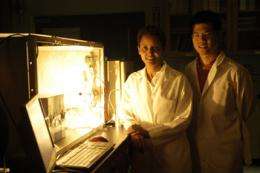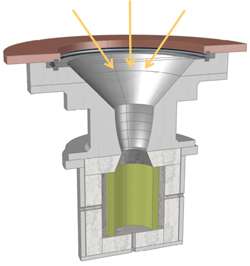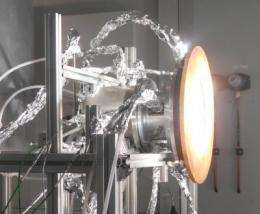New reactor paves the way for efficiently producing fuel from sunlight

Using a common metal most famously found in self-cleaning ovens, Sossina Haile hopes to change our energy future. The metal is cerium oxide—or ceria—and it is the centerpiece of a promising new technology developed by Haile and her colleagues that concentrates solar energy and uses it to efficiently convert carbon dioxide and water into fuels.
Sossina Haile and William Chueh next to the benchtop thermochemical reactor used to screen materials for implementation on the solar reactor.
Solar energy has long been touted as the solution to our energy woes, but while it is plentiful and free, it can't be bottled up and transported from sunny locations to the drearier—but more energy-hungry—parts of the world. The process developed by Haile—a professor of materials science and chemical engineering at the California Institute of Technology (Caltech)—and her colleagues could make that possible.
The researchers designed and built a two-foot-tall prototype reactor that has a quartz window and a cavity that absorbs concentrated sunlight. The concentrator works "like the magnifying glass you used as a kid" to focus the sun's rays, says Haile.
At the heart of the reactor is a cylindrical lining of ceria. Ceria—a metal oxide that is commonly embedded in the walls of self-cleaning ovens, where it catalyzes reactions that decompose food and other stuck-on gunk—propels the solar-driven reactions. The reactor takes advantage of ceria's ability to "exhale" oxygen from its crystalline framework at very high temperatures and then "inhale" oxygen back in at lower temperatures.
"What is special about the material is that it doesn't release all of the oxygen. That helps to leave the framework of the material intact as oxygen leaves," Haile explains. "When we cool it back down, the material's thermodynamically preferred state is to pull oxygen back into the structure."
The ETH-Caltech solar reactor for producing H2 and CO from H2O and CO2 via the two-step thermochemical cycle with ceria redox reactions.

Specifically, the inhaled oxygen is stripped off of carbon dioxide (CO2) and/or water (H2O) gas molecules that are pumped into the reactor, producing carbon monoxide (CO) and/or hydrogen gas (H2). H2 can be used to fuel hydrogen fuel cells; CO, combined with H2, can be used to create synthetic gas, or "syngas," which is the precursor to liquid hydrocarbon fuels. Adding other catalysts to the gas mixture, meanwhile, produces methane. And once the ceria is oxygenated to full capacity, it can be heated back up again, and the cycle can begin anew.
For all of this to work, the temperatures in the reactor have to be very high—nearly 3,000 degrees Fahrenheit. At Caltech, Haile and her students achieved such temperatures using electrical furnaces. But for a real-world test, she says, "we needed to use photons, so we went to Switzerland." At the Paul Scherrer Institute's High-Flux Solar Simulator, the researchers and their collaborators—led by Aldo Steinfeld of the institute's Solar Technology Laboratory—installed the reactor on a large solar simulator capable of delivering the heat of 1,500 suns.
In experiments conducted last spring, Haile and her colleagues achieved the best rates for CO2 dissociation ever achieved, "by orders of magnitude," she says. The efficiency of the reactor was uncommonly high for CO2 splitting, in part, she says, "because we're using the whole solar spectrum, and not just particular wavelengths." And unlike in electrolysis, the rate is not limited by the low solubility of CO2 in water. Furthermore, Haile says, the high operating temperatures of the reactor mean that fast catalysis is possible, without the need for expensive and rare metal catalysts (cerium, in fact, is the most common of the rare earth metals—about as abundant as copper).

In the short term, Haile and her colleagues plan to tinker with the ceria formulation so that the reaction temperature can be lowered, and to re-engineer the reactor, to improve its efficiency. Currently, the system harnesses less than 1% of the solar energy it receives, with most of the energy lost as heat through the reactor's walls or by re-radiation through the quartz window. "When we designed the reactor, we didn’t do much to control these losses," says Haile. Thermodynamic modeling by lead author and former Caltech graduate student William Chueh suggests that efficiencies of 15% or higher are possible.
Ultimately, Haile says, the process could be adopted in large-scale energy plants, allowing solar-derived power to be reliably available during the day and night. The CO2 emitted by vehicles could be collected and converted to fuel, "but that is difficult," she says. A more realistic scenario might be to take the CO2 emissions from coal-powered electric plants and convert them to transportation fuels. "You'd effectively be using the carbon twice," Haile explains. Alternatively, she says, the reactor could be used in a "zero CO2 emissions" cycle: H2O and CO2 would be converted to methane, would fuel electricity-producing power plants that generate more CO2 and H2O, to keep the process going.
A paper about the work, "High-Flux Solar-Driven Thermochemical Dissociation of CO2 and H2O Using Nonstoichiometric Ceria," was published in the December 23 issue of Science.
Provided by California Institute of Technology

















